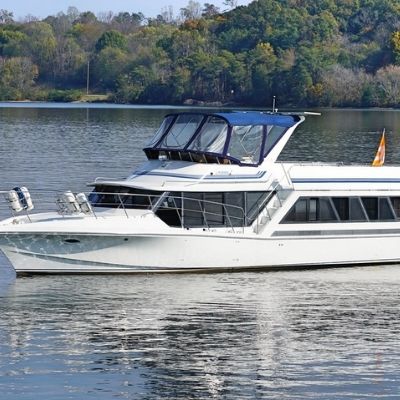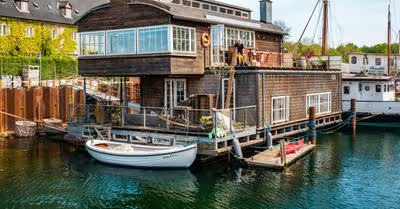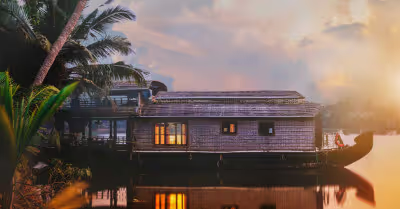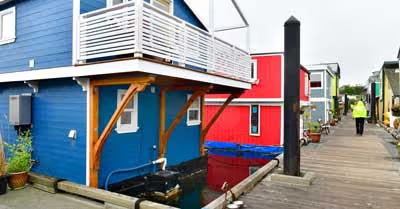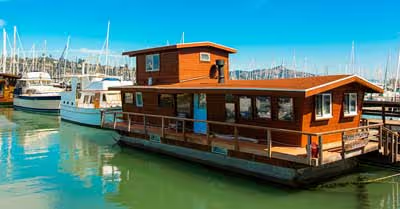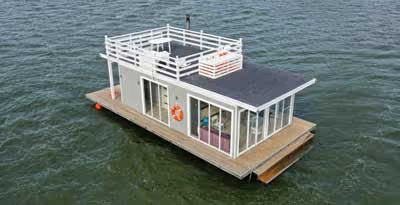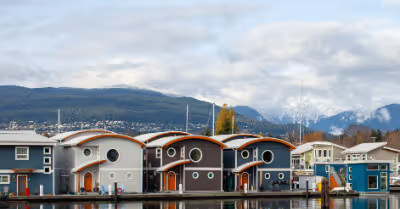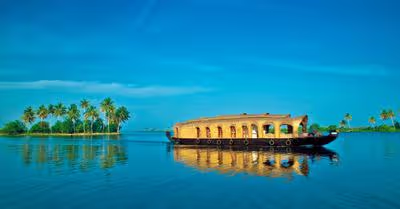
Most houseboats aren’t designed to be ocean-going, but a few have true offshore cruising capabilities.
The best blue water houseboats are manufactured by a company called Bluewater. These vessels are between 50 and 60 feet in length and feature houseboat-like accommodations on a seaworthy hull. The best models are the Bluewater 5200 and the Bluewater 55.
In this article, we’ll explain the differences and similarities between offshore cruising houseboats and traditional inland houseboats. We’ll differentiate between “blue water” and Bluewater brand houseboats and review two of the best and most popular ocean-going houseboat models.
We sourced the information used in this article from used boat guides and from the online houseboat community.
Do Blue Water Houseboats Exist?
Generally speaking, when we think about houseboats, we picture long flat-bottomed boats with a shallow draft and a high freeboard. In other words, a vessel that’s not suitable for any sort of open-ocean travel. But is there a different kind of houseboat that’s designed for traveling offshore?
Bluewater Brand Houseboats
Bluewater is actually the name of a company that produces coastal cruising houseboats. Bluewater brand houseboats are (by far) the most common offshore cruising houseboats on the market, and the name has become universally recognizable.
Offshore Coastal Cruising Houseboats
Yes, there are houseboats that are designed for offshore use. These vessels are essentially large powerboats with more luxurious and spacious accommodations than traditional “sport fisher” type powerboats. Coastal blue water houseboats have robust hulls for navigating in actual ocean conditions but interiors quite similar to a standard river or lake houseboat.
How Blue Water Houseboats Differ
Blue water houseboats differ from traditional cruising houseboats in a number of ways. The most obvious visual difference is the shape of the hull. Unlike traditional houseboats, which have long box-like hulls, blue water houseboats have noticeable curvature at the bow and a more seaworthy hull shape.
Blue water houseboats have a more robust propulsion and steering system, as they have to overcome wind and wave conditions that never occur in typical house boating locations. They’re usually equipped with twin V8 marine diesel engines, dual propellers, and sometimes dual rudders as well.
Additionally, most modern blue water houseboats have at least one bow and stern thruster, as their size makes them difficult to dock or maneuver in tight spaces without one. Blue water houseboats also have a navigational fly bridge, which increases visibility and makes careful maneuvering in port much safer.
Everything in engineering is a tradeoff, especially when it comes to boats. As a result, blue water houseboats have some loss of comfort and accommodation to make room for marine systems and necessary seaworthiness modifications. That said, they’re still significantly more comfortable than a typical cruising powerboat.
Similarities Between Blue Water and Inland Houseboats
Blue water houseboats retain some design elements of traditional flat-bottom houseboats, namely the interior. These vessels have spacious interiors, as they’re designed for creature comforts instead of pure utility. Large and open interior spaces, such as the lounge and master bedroom, are almost identical to what you’d find on a traditional houseboat.
Additionally, the superstructure of a blue water houseboat has some notable similarities. For instance, these vessels make use of large windows for ventilation and light. Additionally, they have high ceilings and a spacious upper deck for navigation and recreation.
All of these features, when combined with the ability to cruise offshore in salt water and on extended voyages, make blue water houseboats an attractive option. People who live on or frequently use traditional houseboats will find the conditions onboard to be impressive and surprisingly comfortable for a ‘real’ ocean-going boat.
Where Can Blue Water Houseboats Cruise?
Blue water houseboats are much more seaworthy than traditional houseboats and are generally classified as “coastal cruising” vessels. This means that they can travel reasonably far on the open ocean but are designed for use closer to shore.
Blue water houseboats are not ocean-crossing vessels. They lack the fuel capacity to travel across the wide-open ocean, and they’re also not designed to handle some of the extreme weather often encountered offshore. Large windows, a lack of watertight doors, and their size are limiting factors.
Best Offshore Cruising Houseboats
There are only a few manufacturers of blue water cruising houseboats, and they all stand out for their standard features, quality, accommodations, and popularity. Here are some of the best blue water houseboats and what makes them a great option for living aboard or coastal cruising.
1. Bluewater 55 Coastal Cruiser
Picture of the Bluewater 55 Coastal Cruiser
Bluewater (the company) is one of the most well-known producers of ocean-going houseboats. These vessels, technically classified as coastal cruisers, are some of the most spacious and comfortable power boats on the market. The best of these vessels were produced in the late 1980s, when prices were good and build quality reached its peak.
The Bluewater 55 is a 55-foot vessel with a sleek cruiser hull and a long superstructure that closely resembles a typical houseboat. The long superstructure makes use of all the usable space inside and gives the boat an open and roomy feel.
The bow is flared, mimicking the classic “Atlantic bow” developed to prevent waves from breaking on the bow and dumping water on the decks. Additionally, the bow is flat and a usable area for sunbathing and enjoying the weather. There’s a power winch for raising the anchor, which can be done remotely to keep the passengers and crew from straining themselves.
Above the cabin is a large fly bridge that features the vessel’s exterior control station. This control station is almost a mirror of the interior controls, featuring a helm, throttle, and all of the necessary switches and gauges for navigation. Additionally, a captain’s chair and a large couch area are present for guests to enjoy.
The rear deck is extremely spacious and has enough room for six or more adults to hang out comfortably. It’s covered, which offers shielding from the sun and keeps furniture dry during the occasional squall. The interior features home-like furniture and wood paneling for a warm, luxurious atmosphere.
The beauty of the Bluewater 55 is its size and spaciousness. The interior can be outfitted like an actual home, which gives the passengers all the comforts they’ve come to expect from traditional houseboats. Additionally, plenty of customization of the interior layout is possible, as it’s open and nothing is permanently affixed from the factory.
Many Bluewater 55 houseboats are gasoline-powered, which is less efficient than diesel but much easier to maintain. Gasoline engines are less picky about fuel quality and prone to less catastrophic failure due to dirt or water in the fuel. The hull material is fiberglass, and it features two 350 hp 454 cubic-inch GM gasoline inboard engines.
Bluewater 55 Houseboat Prices
Bluewater 55 houseboats are available on the used market in many locations and can be purchased for around $100,000, depending on the condition. The least expensive Bluewater 55 we found went for $80,000, while the finest models cost upwards of $155,000 or more.
2. Bluewater 52 and Bluewater 5200
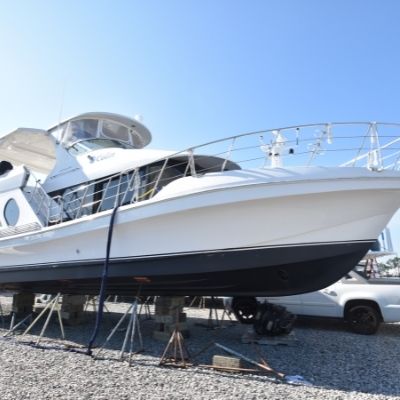
Picture of the Bluewater 52 and Bluewater 5200
The Bluewater 52 is another outstanding cruising houseboat that’s designed for coastal cruising and offshore travel. This newer model features modern accommodations and a sleek yacht-like design. These vessels can be seen making the transit from Florida to the Bahamas and similar journeys, and they make an excellent liveaboard in coastal cities.
This vessel, manufactured by Bluewater, measures about 52 feet in length and is capable of salt water cruising. It’s powered by twin Cummins Diesel engines with an output of 370 hp each, or 740 hp total. From the factory, this vessel came with many modern features such as a stereo system, and many come with integrated electronic navigation. Newer versions of the Bluewater 52 are known as the Bluewater 5200–this nomenclature is common in modern recreational boat design.
The fuel and water storage on the Bluewater 52 is excellent and suitable for extended cruising. This 52-foot vessel has 375 gallons of fuel capacity, 136 gallons of fresh water storage, and 60 gallons of wastewater holding. That means there’s no need to hold off on that hot shower or doing the dishes.
The vessel has two dedicated bathrooms with showers for the master bedroom and the guests. The interior is spacious and well designed but uncluttered. This allows owners to use whatever furniture they like, provided it can be secured for the occasional rough weather encounter.
The Bluewater 52 is slightly smaller than the Bluewater 55, and the interior is a bit less spacious. But all things considered, there’s still an enormous amount of space compared to typical powerboats. Additionally, it features a large fly bridge area for fair-weather navigation and a small afterdeck, which functions more like a swim platform than an outdoor saloon.
Bluewater 52 Pricing
The Bluewater 52 and the Bluewater 5200 were produced more recently than the Bluewater 55, and prices reflect it. You can find a Bluewater 5200 in good to excellent condition for around $200,000 on average, though the finest and latest models cost more.



